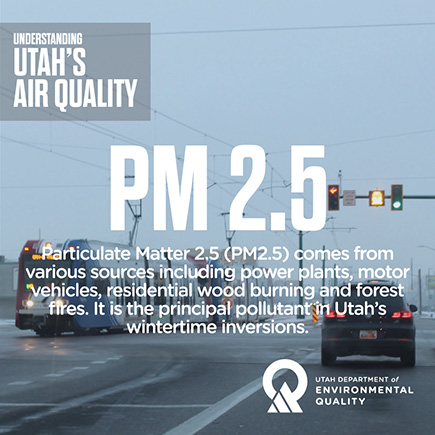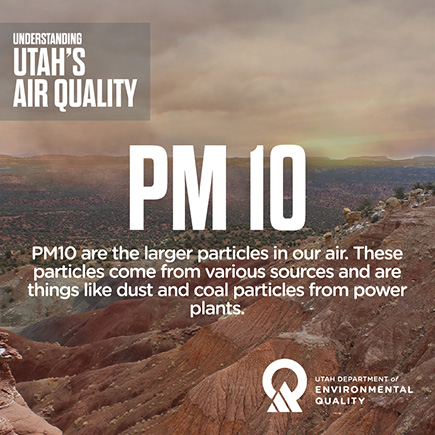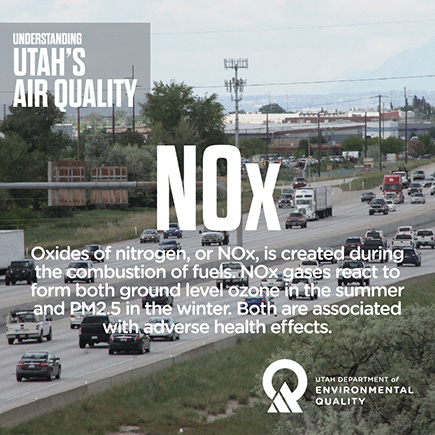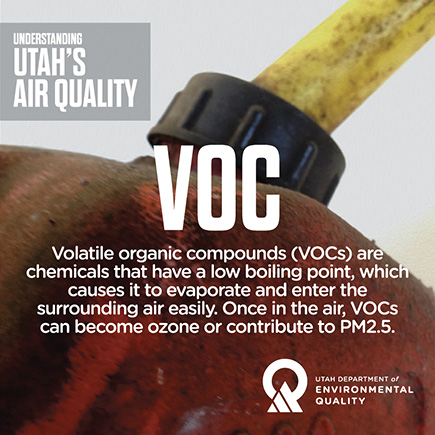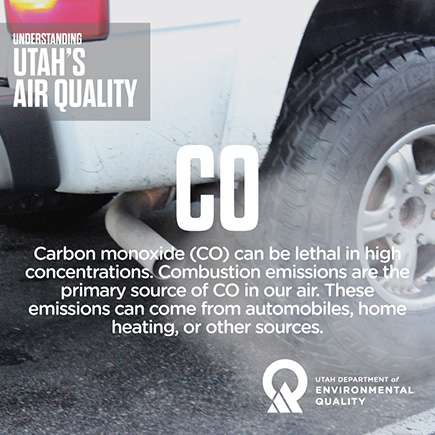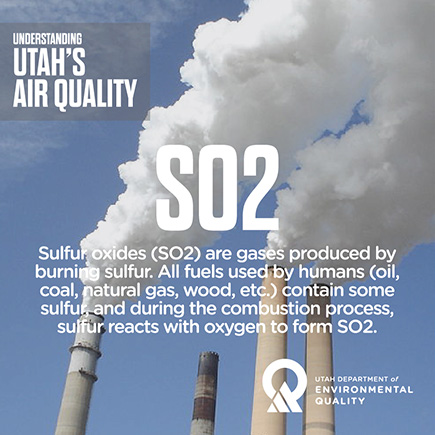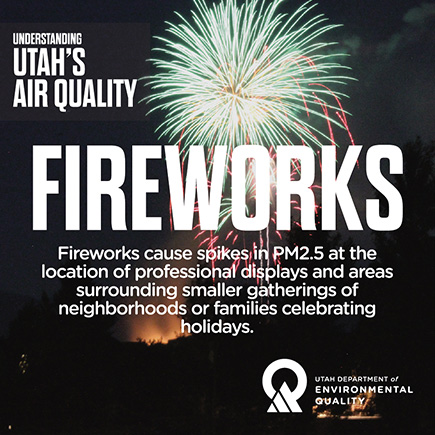By Bo Call
Utah’s Department of Environmental Quality’s Division of Air Quality often hears from residents who want to know more about Utah’s air quality, the pollutants, the causes, and what they can do to help reduce their emissions. Our scientists and engineers, through legislative funded air quality research and partnerships with state and federal agencies are learning more every day about the complex chemistry that creates our state’s unique air quality challenges. Here is a quick overview of the chemicals we look for when monitoring the air and the sources of these pollutants.
PM2.5
PM2.5 is the main component of Utah’s wintertime air pollution. PM2.5 refers to microscopic particles, or particulate matter (PM), that have a diameter of less than 2.5 micrometers—smaller than pollen and most bacteria.
During an inversion, temperatures increase with increasing altitude—the inverse of what normally happens. The warm inversion layer then acts as a cap and stops atmospheric mixing. This holds PM2.5 near the ground and causes the smog that occasionally covers the valleys of Northern Utah.
Sources of PM2.5 are broken down into three categories: point sources, mobile sources, and area sources. Point sources (13 percent of a typical inversion) are large stationary industrial or commercial facilities. Mobile sources (48 percent of a typical inversion) are non-stationary sources such as vehicles, trains and aircraft. Area sources (39 percent of a typical inversion) are smaller stationary sources. These include emissions from home heating, smoke from wood burning, and emissions from small businesses like restaurants and dry cleaners.
Ozone
Ozone is formed when oxides of nitrogen (NOx) and volatile organic compounds (VOC) break apart in the presence of sunlight and high temperatures and recombine into new structures, creating ozone. Ozone at ground level is a harmful air pollutant that damages human health and vegetation. It is a key ingredient in summertime smog and haze.
Approximately 90 percent of atmospheric ozone occurs naturally and is located in the stratosphere to protect the earth from the sun’s ultraviolet rays. The remaining 10 percent of ozone is located at ground level and is a result of compounds emitted from automobiles, industrial facilities, and household products.
Breathing ozone can damage lung tissue. Low amounts can cause chest pain, coughing, shortness of breath and throat irritation. Ozone may also worsen chronic respiratory conditions and compromise the ability of the body to fight respiratory infections.
PM10
Like PM2.5, PM10 is the measurement of particulate matter. These are the larger particles in our air. Commonly, these particles are things like dust and coal particles from power plants. Sources of PM10 include crushing or grinding operations, wind-blown dust and dust stirred up by vehicles on roads. PM10 also comes from combustion in car engines, home heating and industrial sources.
Exposure to PM10 can cause a number of health problems including coughing and wheezing to asthma attacks. PM10 can also aggravate lung and heart conditions.
NOx
Oxides of nitrogen, or NOx, are poisonous, highly reactive gases. These gases form when fuel is burned at high temperatures. Sources of NOx pollution include automobiles and non-road vehicles (planes, boats, etc.) as well as industrial sources such as power plants, boilers, and turbines. When NOx reacts with VOCs near ground level on hot summer days, it produces ozone. NOx is also a direct component of PM2.5 pollution.
VOC
Volatile organic compounds are released into the air mostly during the manufacture or use of everyday products and materials. Some common sources or VOCs include the fumes from fuels, personal hygiene products, cleaning agents, paints, and other solvents used commercially or in homes.
When VOCs mix with sunlight and NOx, ozone is formed. In the wintertime, VOCs combine with other chemicals to form ammonium nitrate, a precursor to the formation of PM2.5.
CO
Carbon monoxide (CO) can be lethal in high concentrations. The concentration of CO in the air depends on local weather conditions and the number of automobiles in the area. High levels of CO can have acute health effects on humans by reducing the supply of oxygen in the bloodstream. Combustion emissions are the primary source of CO in our air. This can come from automobiles, home heating, or other sources.
SO2
Sulfur oxides (SO2) are gases produced by burning sulfur. All fuels used by humans (oil, coal, natural gas, wood, etc.) contain some sulfur, and during the combustion process, sulfur reacts with oxygen to form SO2. The primary source of sulfur oxides is the burning of fossil fuels, particularly coal. Since the introduction of catalytic converters in automobile, SO2 has mostly disappeared from Utah’s air.
SO2 can combine with particles and moisture in the air and contributes to the formation of acid rain by transforming into sulfuric acid in the atmosphere. Acid rain can damage lakes and aquatic life, building materials, and plant life.
Wood Smoke
Wood smoke, or solid fuel smoke, is the product of incomplete combustion, which releases VOCs, NOx, and fine particulates as the wood/solid fuel burns. In addition to the direct PM2.5 emitted from burning, VOCs and NOx react to form PM2.5. During inversions, these particles build up in the valleys, sometimes reaching unhealthy levels.
Fireworks
Utah’s Division on Air Quality regularly sees significant spikes in concentrations of both PM10 and PM2.5 associated with fireworks displays. These spikes occur in the location of professional displays and also areas surrounding smaller gatherings of neighborhoods or families celebrating the holidays with displays of their own.
Those most affected are the young, the elderly, and those sensitive individuals with respiratory conditions.
What is Utah doing?
Utah has taken extraordinary steps to improve air quality. Below is a listing of just a few of the recent steps taken to clear up Utah’s air.
Large industry in Utah has reduced emissions by 47 percent since 1995 as a result of state and federal requirements.
The State has enacted 30 new rules that reduce emissions from the area sources. As an example, one of those regulations requires that consumer products sold in Utah be formulated to reduce VOCs. This step will remove 2,000 tons of pollutants from our air annually.
Utah is experiencing a solar energy boom, adding approximately 800 MW of utility-scale solar capacity since 2014. Demand for residential rooftop solar is also growing rapidly. State incentives—the Renewable Energy Systems Tax Credit and the Alternative Energy Development Incentive—have spurred this growth.
DEQ’s Division of Air Quality scientists have conducted or overseen many research projects to understand the Utah-specific chemical reactions that form pollution and identify effective control technologies to reduce that pollution.
In 2016, the Legislature passed a bill requiring that, starting in 2018, new water heaters sold in the state must include the latest technology (Ultra-low NOx), reducing NOx emissions by 75 percent compared to conventional water heaters.
Governor Herbert is using all available tools to encourage Utah refineries to produce the cleaner Tier 3 fuel. Federal Tier 3 fuel and vehicle standards are projected to cut emissions from cars and trucks in half. Model 2017 vehicles meet the Tier 3 vehicle standards.
What can you do?
- Conserve energy – remember to turn off lights, computers, and other appliances.
- Get in the habit of setting your thermostat a few degrees warmer in the summer and a few degrees cooler in the winter.
- Use energy efficient light bulbs and appliances.
- Limit driving and practice TravelWise strategies like carpooling, public transit, biking and walking.
- Combine errands for fewer trips.
- Keep your automobile well maintained. Follow the manufacturer’s recommendations on routine maintenance and check tire pressure and wheel alignment.
- Avoid idling your automobile.
- Use electric or hand-powered lawn tools.
- Use a modern gas can to limit emitting fumes and spilling gasoline.
- Run dishwashers and clothes washers only when full.
- Choose environmentally responsible home cleaners.
To learn more about the ways you can reduce emissions and help improve Utah’s air quality, visit www.ucair.org.
I have been with the Division of Air Quality (DAQ) for 25 years, managing the air monitoring section since 2009. Prior to that I worked in DAQ’s compliance branch and conducted source inspections, specializing in asbestos rules and enforcement.I have a BA in Biology from Utah State University. I am a retired member of the Air Force Reserve as a Transportation Specialist. On my own time, I have a hobby farm and recently entered into the realm of beekeeping.

